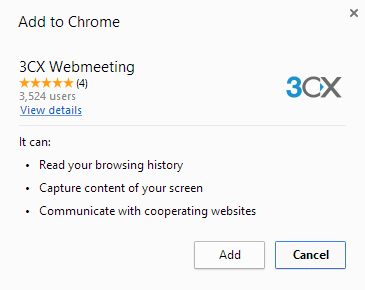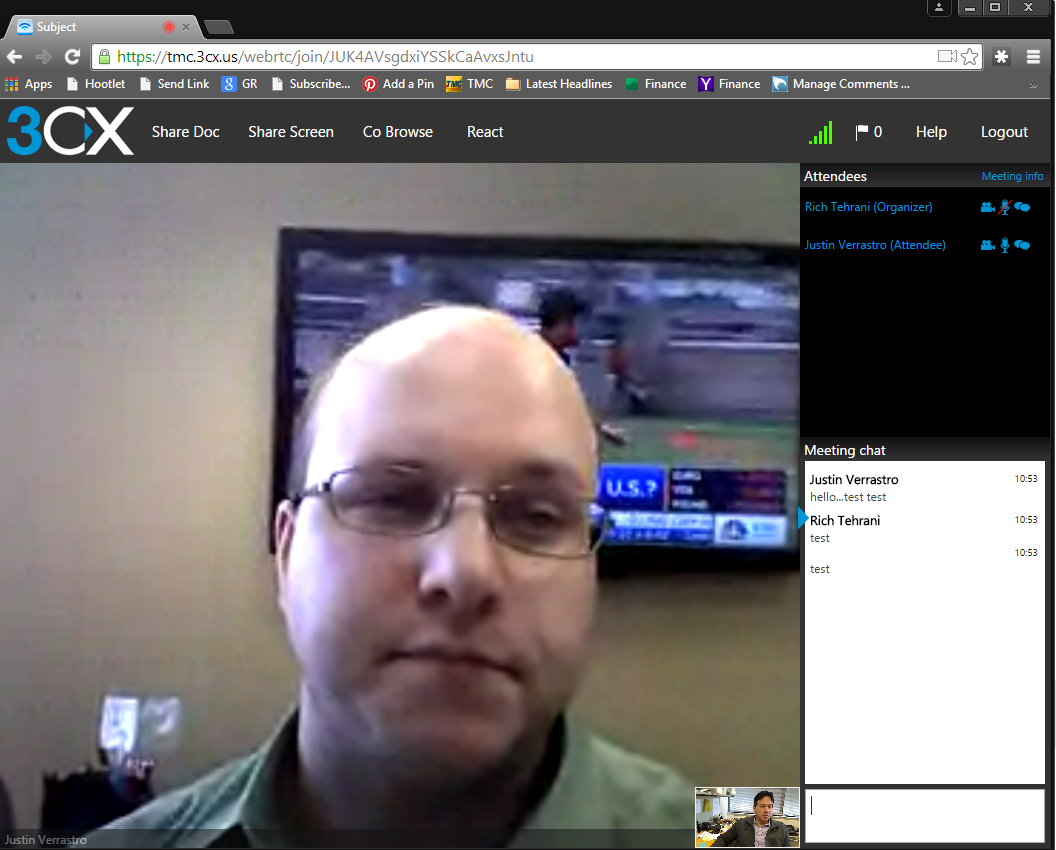As we installed and tested 3CX WebMeeting for this review we couldn’t help thinking that WebRTC is doing to conferencing what VoIP did to traditional phone systems over the last few decades. After all, companies like Cisco and ShoreTel (News ![]() - Alert) didn’t make phone systems 20 years ago, yet today they are big players in the space.
- Alert) didn’t make phone systems 20 years ago, yet today they are big players in the space.
VoIP allowed them an opportunity to ride the wave of disruption to marketshare. In addition, all the cloud telephony vendor solutions are based on VoIP and are also taking share from legacy phone systems. WebMeeting is a reasonably priced conferencing system for offices which has its roots in WebRTC, the Google (News ![]() - Alert)-backed standard that has shaken up the entire technology space due to its ease-of-integration and ubiquity – working with Chrome, Firefox and even Microsoft IE to some extent.
- Alert)-backed standard that has shaken up the entire technology space due to its ease-of-integration and ubiquity – working with Chrome, Firefox and even Microsoft IE to some extent.
Installation
We installed 3CX Phone (News - Alert) System on a dedicated machine and created a record in our DNS so we could access 3CX Phone System by name rather than IP address. We then configured Server Manager with mail server settings, set up an administrator, and created additional users with extensions. Finally, we clicked on users in Server Manager and sent them a welcome email which included a configuration file attachment. When the user clicks on it, it configures the 3CXPhone desktop application.
We also installed the app via the app store on an iOS-based iPhone (News - Alert) 6 Plus.
Documentation/Training
There is documentation for the server as well as the user portion of the software. The server portion consisted of areas such as extension management which showed us how to create new extensions.
The user manual showed us how to create 3CX WebMeetings, join them, share documents, the screen, CoBrowse, manage media access and take advantage of the document converter.
When you click on one of the blue links related to an option, you are taken to a new page with pictures and step-by-step instructions.
Features
There are a lot of great features included in this product, such as one-click conferencing, the lack of a client-install, interoperability between VoIP and video as needed, and bandwidth management and control. In truth, this last feature touted by the company is somewhat common these days, but as you will read below – it worked well.
In addition, there are file- and screen-sharing options as well as co-browsing built in.
Build/Design
This past December, we reviewed 3CX Phone System in INTERNET TELEPHONY’s December issue and rated it a solid buy. We liked the interface then, and the WebMeeting option is somewhat of an add-on to the system, which leverages the same interface. It looks great. It is intuitive, seamless, easy to use, and flows well between desktop and mobile devices.
Performance/Quality
All functions were instantaneous but obviously depend on the amount of bandwidth on your network. We performed all of our tests on our in-house TMC (News - Alert) corporate network. Some clients were over Wi-Fi and others connected via Ethernet. Quality was acceptable. Typically the videoconferences used about 256kbps. We thought video quality was a nice compromise between super-high-resolution telepresence systems and something which doesn’t tax the clients too much. While conferencing, we hammered our production network with traffic and noticed the video quality fluctuated as we did so. In addition, walking laptops around our offices showed quality variances as we hopped between access points and discovered weaker coverage areas.
We also tried screen sharing, and when we did so on a system with three monitors, we were presented with screens to choose from. Once we selected one, sharing happened instantly over our network, allowing others to see the selected information.
Differentiation
As a dead-easy add-on to your phone system, WebMeeting by 3CX is a no-brainer product. You get lots of great collaboration features built into a single interface. There is really no real user training needed to leverage this system and no new software to install. It just works.
Having said that, you will need to install Chrome browser extensions.
Another major benefit of the system is its ability to support videoconferences with internal users without the need to use your WAN bandwidth. If you have a large office and prefer not to go to a central conference room, or perhaps you don’t have one, it won’t tax your Internet connection to perform conferences all day long.
Ease of Use
A few clicks here and there is really all it took to get this product running. The options were clearly outlined in the menus. In short, there wasn’t much to learn to get this product working.

Value
The most expensive solution would be for 25 users where your cost would be just under $23.80 per year for a user – assuming, of course, you have the full 25 people in your company using the system. At the other end, an organization with 100 people using the system would pay $21.95 per year per user. If we were to compare this to WebEx, 100 users would cost you $1,068 per year if you pay monthly. You’d get lots of good conferencing features but not the deep UC integration where you can use a seamless interface for audio, video, and screen sharing.
|
Product |
Euro |
USD |
|
3CX WebMeeting 25 participants |
495 |
595 |
|
3CX WebMeeting 50 participants |
975 |
1,095 |
|
3CX WebMeeting 100 participants |
1,975 |
2,195 |
Support
Our support contact was located in Europe, which made communications a bit slower than if the resource was on the East Coast of the U.S. where TMC Labs is based. Nonetheless, the email answers we received were excellent and helped with any issues we threw at them. And, we should note, there is U.S. support available.
Room for Improvement
We noticed that when we launched videoconferences, the initiator of such a call had to manually enable the cameras of the participants. There may be instances where this may not be the desirable option. However, 3CX informs us that it is possible to enable video when setting up the call.
We would also like to see video call inclusion on the iOS platform. Finally, we’d like to see Firefox support in the future. Chrome is free, so it really isn’t a cost issue, but if there is no Firefox support, then there should be a way to initiate WebMeetings in a Chrome browser instead of Firefox (which was the default on our test system). It wasn’t a huge deal, but in order to get our conferences working properly we just pasted the URL from the Firefox tab into Chrome.
Bottom Line
At around $20 per user per year for full collaboration integrated into a UC system, 3CX WebMeeting is a solid value and makes even more sense if the company is to also provide your phone system. If you like having Windows servers as opposed to relying on the cloud or Linux, then 3CX is the definite way to go. If you like easy-to-use systems where little downloading and training is needed and users can still be very productive, then this system is also for you. One final point is WebRTC is the key enabler of this solution and as it becomes even more popular and compatibility issues are resolved, expect even better client support for it and 3CX WebMeeting.
Ease of Install: 5
Ease Of Use: 5
Interface: 4
Functionality: 5
Overall Rating: 5
Edited by Dominick Sorrentino




